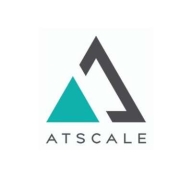


AtScale is the leading provider of intelligent data virtualization for big data analytical workloads, empowering citizen data scientists to accelerate and scale their business’ data analytics and science capabilities and ultimately build insight-driven
AtScale connects people to live disparate data without the need to move or extract it, leveraging existing investments in big data platforms, applications and tools. AtScale creates automated data engineering using a single set of semantics so consumers can query live data (either on premise or in the cloud) in seconds without having to understand how or where it is stored—providing security, governance and predictability in data usage and storage costs.
Benefits:
No data movement: AtScale is agnostic to data platforms and data location, whether on-premises or in the cloud, in a data lake or a data warehouse.
Automatic “smart” aggregate creation: AtSacle’s intelligent aggregates adapt to the data model and how it is used, automating the data engineering tasks required to support those activities and reducing time spent from weeks to hours.
Use your existing BI and AI tools: AtScale provides access to live, atomic-level data without the user needing to understand where or how to access the data, so you can keep using your tools of choice.
No more extracts or shadow IT: AtScale eliminates the need for extracts with a single, consistent, governed view of live data, regardless of which BI and AI tools are used.
Data-as-a-service: AtScale allows metadata to be created once, with centrally defined business rules and calculations, exposing data assets as a service.
Data platform portability: Models built in AtScale are portable, with no need to recreate them for different platforms. AtScale can easily be repointed to new data platforms, making migration seamless to business users.
Faster time-to-insight: AtScale reduces time-to-insight from weeks and months to minutes and hours. AtScale virtual models can be created and deployed in no time, with no ETL or data engineering.
Future-proof your data architecture: AtScale alleviates the complexities of data platform and analytics tool integration, making cloud, hybrid-cloud and multi-cloud data architectures a reality without compromising performance, security, agility or existing governance and security policies.
Features:
Design CanvasTM: AtScale’s Design Canvas visually and intuitively connects to any data platform, allowing you to create virtual multidimensional cubes without ETL.
Autonomous Data Engineering: Just-in-time query optimization that anticipates the needs of the data consumer.
Universal Semantic LayerTM: A workspace with a Design Canvas for your data consumers to define business meaning and get a single-source-of-truth.
Security & Data Governance: Centralized security policy to decentralize access using the tenants of Zero Trust.
Virtual Cube Catalog: A gateway to data that is easily discoverable and frictionless—and available to use every day, en masse.
AtScale connects people to live disparate data without the need to move or extract it, leveraging existing investments in big data platforms, applications and tools. AtScale creates automated data engineering using a single set of semantics so consumers can query live data (either on premise or in the cloud) in seconds without having to understand how or where it is stored—providing security, governance and predictability in data usage and storage costs.
Dremio is a data analytics platform designed to simplify and expedite the data analysis process by enabling direct querying across multiple data sources without the need for data replication. This solution stands out due to its approach to data lake transformation, offering tools that allow users to access and query data stored in various formats and locations as if it were all in a single relational database.
At its core, Dremio facilitates a more streamlined data management experience. It integrates easily with existing data lakes, allowing organizations to continue using their storage of choice, such as AWS S3, Microsoft ADLS, or Hadoop, without data migration. Dremio supports SQL queries, which means it seamlessly integrates with familiar BI tools and data science frameworks, enhancing user accessibility and reducing the learning curve typically associated with adopting new data technologies.
What Are Dremio's Key Features?
What Benefits Should Users Expect?
When evaluating Dremio, potential users should look for feedback on its query performance, especially in environments with large and complex data sets. Reviews might highlight the efficiency gains from using Dremio’s data reflections and its ability to integrate with existing BI tools without significant changes to underlying data structures. Also, check how other users evaluate its ease of deployment and scalability, particularly in hybrid and cloud environments.
How is Dremio Implemented Across Different Industries?
Dremio is widely applicable across various industries, including finance, healthcare, and retail, where organizations benefit from rapid, on-demand access to large volumes of data spread across disparate systems. For instance, in healthcare, Dremio can be used to analyze patient outcomes across different data repositories, improving treatment strategies and operational efficiencies.
What About Dremio’s Pricing, Licensing, and Support?
Dremio offers a flexible pricing model that caters to different sizes and types of businesses, including a free community version for smaller teams and proof-of-concept projects. Their enterprise version is subscription-based, with pricing varying based on the deployment scale and support needs. Customer support is comprehensive, featuring dedicated assistance, online resources, and community support.
We monitor all Data Virtualization reviews to prevent fraudulent reviews and keep review quality high. We do not post reviews by company employees or direct competitors. We validate each review for authenticity via cross-reference with LinkedIn, and personal follow-up with the reviewer when necessary.